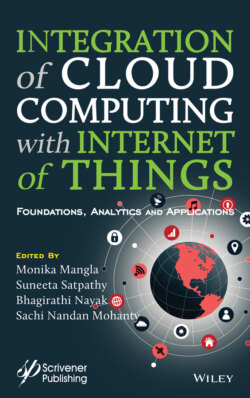Читать книгу Integration of Cloud Computing with Internet of Things - Группа авторов - Страница 16
1.3 The IoT Domains 1.3.1 The IoT Policy Domain
ОглавлениеThe policy-based IoT intends to develop, plan, and implementation of suitable rules, strategies, and policies concerned with IoT devices based on real-time data for future impact and possible environment sustainability. It helps in efficient energy management, data management, resource utilization, and user feedback that benefit the industries as well as the end-user. A few areas of policy-based IoT application are shown in Figure 1.2.
The application of policy-based IoT in smart cities helps to plan for smart healthcare, smart vehicles, smart homes, smart security, smart campuses, smart agriculture, etc. [1]. Due to scare, limited and rapid depleting of resources with an increase in global population, it demands .a smart city environment for the future generation. With the advent of industrialization and the emission of poisonous gas particles, the world becomes unhealthy and suffocated. Further, many environmental hazards such as global warming, climate change, acid rain, soil erosion, etc. tend to threaten the world ecosystem. This has compelled the government agencies, NGOs, and policymakers to find different means or ways to contain the carbon footprints that grow exponentially. To be successful, the policies and strategies must appeal and be conducive to the manufacturers, designers, service providers, as well as the end-users with energy-efficient systems. Such planning, policies, regulations, etc. facilitate the smart environment where people can utilize the air conditioners, computer labs, sensors, and networking systems with desire for economical effectiveness. The IoT application in smart cities provides the provision to many factors such as
Smart Agriculture: Smart agriculture based on the IoT aims to integrate several heterogeneous devices, objects, equipment such as the wearable sensors, humidity sensors, temperature sensors, mobile phones, etc. with the networking system to remain successful [14].Figure 1.2 Policy-based IoT applications.
Smart healthcare: It requires a context-aware linking system to be efficient and viable linking the agriculture, healthcare, and environment [15]. The IoT must cater to a remote health monitoring system while managing huge data by applying visualization and data mining. The linking of the IoT green computing to health industries can infuse flexibility, interoperability, and intelligence by information transmission among different modules of the healthcare system. This reduces and simplifies the administrative task.
Smart security: The world becomes small due to the use of IoT. This makes the people, installations, equipment, etc. vulnerable to cyber-attack. The loss, theft, and exposure of private information become common today due to network interconnectivity. The IoT system must be capable to safeguard from pilferage or leakage of sensitive information by taking preventive measures. This way, it can avoid unwanted threats to national, environmental, social, and personal entities by providing smart security with efficient IoT gateways [16]. It requires the provision of password protection systems, ciphering or cryptographic or jumbling technologies, robust routing mechanism. The security clearance is a must at every level to maintain information integrity, confidentiality, authenticity.
Smart homes: The IoT-based smart homes help the end-users to cope and deal with their busy schedules by interlinking the sensors, electronic gadgets, etc. with software set up in homes [13]. The equipment such as the computer, mobile phone, air conditioner, lighting, heating mechanism, ventilation, security systems, hardware, etc. connected through networking and sensors benefit from these ends irrespective of time and place.
Smart vehicles: The IoT-based smart transport system equipped with smart servers can provide e-notification, traffic and weather updates, automated accident detection, etc. to drivers and vehicle owners to save up on their energy and time. It helps to restrict the vehicle speed under adverse weather condition and traffic congestion by estimating the distance traveled the driver reaction time, etc. The associated systems such as the GPRS tracking, emergency prioritization, vehicles, GSM modem, infrared proximity sensors, Xbee, embedded processor are few contributions of smart vehicle systems [12]. Similarly, smart vehicles that can handle and inform human affective states can provide a warning to a passenger or the driver for timely action by alerting the traffic management system in case of emergency [17].
Smart campus: The resources are scarce and are rapidly depleting with an increase in the global population, hence they are limited. Further, it is not advisable to neglect the environmental effect.
Climate change, soil erosion, global warming, acid rain, etc. in the exploration of resources on a large scale. It demands awareness among the consumers, manufacturers, designers, service providers, to develop energy-efficient IoT system for smart cities. In this regard the role of NGOs, educational institutions, think tanks, intellectuals remain vital to promoting green residences or campuses. This can be possible by providing automatic monitoring and control of IoT devices focusing on the economy, energy-efficient, reliability, etc. [18].
